ShodhKosh: Journal of Visual and Performing ArtsISSN (Online): 2582-7472
|
|
SATTRIYA DANCE: AN AESTHETICAL OUTLOOK
1 Assistant
Professor, Department of Performing Arts, Majuli
University of Culture, Majuli, Assam, India
|
|
ABSTRACT |
||
|
Aesthetic is
the pursuits of one’s individual mind. The theory or sense of beauty is
always in connotation with art appreciation or criticism and is cultivated in
the responsive spectators. The aesthetic experience evolve
among the sahridaya and varies from
person to person depending upon the perception of beauty. Indian Classical
Dances are sacred art forms associated with the union of individual soul with
the Absolute. They imbibe the spiritual values. Sattriya dance, one of the classical dance form
from Assam, created by the great saint Sankaradeva in the 15th -16th century was a product of neo-vaishnavite movement. This form carrying the legacy of living tradition till
today is performed in the Sattra precinct as a ritual
service to appease the almighty while simultaneously seen performing on stage
to appease the audience. This research paper is an attempt to assess the
aesthetic qualities of Sattriya dance
and to evaluate the aesthetic experience that arise out of the dance form in
the minds of the spectators. The paper will be based on secondary sources
comprising magazines, books, journals and internet content. |
|||
|
Received 07 August 2023 Accepted 16 January 2024 Published 23 January 2024 Corresponding Author Dr.
Dimple Saikia, dimplesaikia89@gmail.com
DOI 10.29121/shodhkosh.v5.i1.2024.639 Funding: This research
received no specific grant from any funding agency in the public, commercial,
or not-for-profit sectors. Copyright: © 2024 The
Author(s). This work is licensed under a Creative Commons
Attribution 4.0 International License. With the
license CC-BY, authors retain the copyright, allowing anyone to download,
reuse, re-print, modify, distribute, and/or copy their contribution. The work
must be properly attributed to its author.
|
|||
|
Keywords: Sattriya Dance,
Aesthetic, Rasa, Aharya, Angika, Music |
|||
1. INTRODUCTION
Among
the arts, dance is one of the most sublime beauty. An
art has the capacity of creating beauty resulting in aesthetic experience in
the minds of the spectators. As aptly says, the beauty of a work of art lies in
the eyes of the beholder. Aesthetic is classified under Philosophy. Sattriya dance is rich in its aesthetical aspects as its
spiritual qualities lie in the philosophy of Vaishnavite
faith.
2. Origin of Sattriya dance
Sankaradeva, the great
saint and philosopher initiated the neo-vaishnavite
movement in Assam in 15th-16th
century with the aim of binding the people of the society irrespective
of caste, creed, religion and gender. The then
society was under the disorder of many evil practices like animal sacrifices in
the name of god, casteism, following different
religious practices and paying homage to various deities. His faith was Ek
Sarana Naam Dharma, where single god, Krishna is worshipped. He strongly opine that worshipping Vishnu is the only means of getting
salvation and to demolish these evil practices from
the society, establishing the paramount glory of krishna
among the masses is the only means. “As the branches, leaves and foilage of a tryee are nourished
by the pouring of water only at the root of the tree, as the limbs of body are
nourished by putting food only in the stomach, so all gods and goddesses are
propitiated only by the worship of Vishnu (Krishna)” Roychoudhury (2013), P. 111. He
believed that instead of providing religious discourses to the people he opted
the audio- visual medium and composed various naats, geets, dances and monumental works on religion to make the
lay people comprehendible on the importance of Krishna. This medium to
propagate the vaishnavite faith provide a fillip to
the Bhakti movement. Sankaradeva composed six naats to propagate the vaishnava faith, later known as Ankiya
naats. These plays are an amalgamation of
dance, music, acting, dialogues and carry the message of Krishna Bhakti to
inculcate conscience within themselves. Here it is worth mentioning of the
contributions of Madhavadeva, Sankaradeva’s
apostle who composed various plays, known as Jhumura
except one, to spread bhakti and to attract the masses to the vaishnava fold. The dances that are within the
theatrical wing along with those outside the theatrical practices are known as Sattriya dance. Due to neo-vaishnavite movement in Assam two significant institutions
fostered the way of life of the people. To proselytise the Ek Sarana Naam
Dharma Sankaradeva established the congregational
prayer hall, devagriha (Sattra)
in Bordowa, Nagaon with the motive to discuss and to
chant Krishna’s glory religiously. In Charit Puthi,
it is beautifully written as:
Sankare Bolonto Bhai Xuniyuko Ramrai
Devagriha Xajio Jotone
Heno Kotha Xunilonto Sattragriha Xajilonto
Ramrai Moharonga mone ||156|| Goswami (2019), P.15
Later
on the devagriha
emerged in a structural form as it is present today (Sattra)
and mention to be made of Madhavadeva and Damodaradeva. Another institution is the Namghar,
which is the central structure of a sattra. Here,
religious discourses, nama kirtan, bhaona performances, are held with the aim of bringing all
the people of village irrespective of caste, creed, religion and gender. All
people are equal in the eyes of law and there is no discrimination while taking
initiation into the Vaishnava faith of Sankaradeva is
the main motive behind it.
Bharata
Natyashastra is considered to be the first work that explains about aesthetics
in Indian traditions. Rasa is the soul of any work on art. The word Rasa was
borrowed from Atharva veda (Rasan atharvanad api) Unni (2014), P. 379 to
explain the theory of dramaturgy by Bharata in the 6th chapter of
Natyashastra as Rasaadhyaya. Rasa is spiritual
and aesthetic. Visvanatha in Sahitya-Darpana says that “aesthetic pleasure and
spiritual pleasure are twin brothers. They are, indeed, not different in kind;
and, if at all, they differ in degree, that is infinitesimal and hence absolutely
negligible. Aesthetic pleasure, too, like spiritual pleasure, is characterized
by disinterestedness and unselfishness” Chaudhay (1991), P. 46. The
concept of Rasa plays’s an important role in dance
and no dance is justified without the experience and appreciation by the
viewers. Rasa is the soul and source of all life. Bharata uses the word rasa in
search of true beauty. He enumerated eight rasas: Sringar,
Hasya, Karuna, Raudra, Vira, Bhayanaka, Bibhastha, Adbhuta. Later
commentators like Abhinavagupta added one more rasa, Santa making them to Nava rasa
Beohar (2015),
P. 189. Vaishnavite philosophers
like Sri Rupa Goswami in Bhaktirasamrtasindhu
and Jiva Goswami in Pritisandharva devised the
concept of priti as a form of bhakti Bandopadhay (2010),
p. 226. Under
bhakti rasa, there are Pancharasa. “The Vaishnava have considered all the rasas under one basic rasa
i.e bhaktirasa or the rasa of devotion.
Within this the other rasas exist” Bandopadhay (2010),
p. 226. The five rasas are: Santa, Dasya, Sakhya, Vatsalya and
Madhura. Rasa is based on the four kinds of abhinaya, angika, vachika, Aharya
and sattvika. Abhinaya is
significant in Indian Classical Dance. It is a medium that bridges a link
between the artist and the audience.
To
relish the beauty of Sattriya dance, it is necessary
to understand the traditional pedagogy and its various aesthetic components
that influences the mind of the viewers. In Sattriya
dance, other rasas are subservient to bhakti rasa. It is of great
importance in Sattriya repertoire. The dancer pays
obeisance to the divine through Vandana (prayer to god),
depicts stories of the divine and even seen representing the divinity through
dance. The composition in Sattriya dance either
begins with praising lord Krishna or Guru Sankaradeva
or verses from sacred manuscripts written by Sankaradeva
and his disciple Madhavadeva. As Sattriya
dance plunged from ankiya naats,
bhakti is incorporated in the entire naat
through songs, dances and dialogues. The Sutradhar keeps on reminding his
audience to look (Shravan) and listen (Kirtan) carefully to the naat and keep on chanting Hari’s name to avail salvation.
Bho bho sabhasadah juyang srinudhwam shradhayadhuna /
Rukmini
haranang naam natakam mukti sadhakam //
Sloka
of Rukmini Harana naat Goswami (2022),
P.34
Another
noteworthy is Dasya bhakti and Atma-nivedan
in Sattriya repertoire where Krishna is the sole
god to be worshipped. In Madhavadeva’s monumental
work Namghosa dasya bhakti
and atma-nivedan can be seen in the
following verses:
Nuhu jana
ami cari jati cari ashrami nuhu
aati
Nuhu dharmasil
danbrata tirthagami /
Kintu
purananda samudrar Gopibharta
pada kamalar
Dasara
dasa tana dasa bhorilu ami //
Sankardeva & Madhabdeva
(2016),
P. 117
I do not belong to the four castes nor I belong
to the four ashramas. I am neither a pious, a donor or a pilgrim. But to the
lord who is the ocean of joy and happiness I become the servant of his lotus
feet.
He
Krishna taju pawe pahilu sarana /
Mayi
anathoro natha tumi Narayana //
Sankardeva & Madhabdeva
(2016), P.
81
Oh lord Krishna being an orphan you are my
preserver and I bow down and self-surrender myself onto your feet to take
refuge.
The Ankiya naat of Sankaradeva, comes to an end with the note of bhakti
rasa. In Ramvijaya naat,
when Ram and Parshuram encountered and the latter was defeated, the dramatist
give the following bhakti words in the mouth of Parshuram as:
“He Prabhu Sri Rama: Tuhu
Parama Isvara: Hamu Tuhari Angsha:
E Najani Darpa Kayolo: Hamaro duho moroho guhai
||” Medhi (1997), P.
270
Merging of the individual self with the absolute
(paramatna) is the static aesthetic feeling
prevalent in the entire Sattriya repertoire.
Angika abhinaya
enhanced the beauty of a dance form. In Abhinaya Darpana, Nandikeshwara
described as:
“Where
the hand goes, let the glance follow
where
the glances lead, there should the mind follows
where
the mind goes, the emotion is generated
where
the emotion is generated, there is the sentiment delineated”
Ramachandrasekhar (2016),
P. 26
The learning of the traditional Sattriya dance form from adhyapak
(guru) is always in oral tradition. The use of hastas,
pada karma, griva bheda, drishti bheda, siro bheda
all makes the Sattriya dance form aesthetically
appealing and helps to create a spiritual ambience among the audience. Matiakhoras are the backbone of the dance form.
These are taught to new learners to make their body flexible and physically
fit. Maheswar Neog cited, according to late Maniram Dutta Muktiyar there are fourty-four matiakhoras, but late Roseswar
Saikia Barbayan promoted the number to sixty-four.
Asom Sattra Mahasabha (association of sattras) stated seventy-three matiakhoras
Kandali (2014), P.
34. Gobinda
Saikia, mentioned 108 matiakhoras relating to
the 108 karanas of Natyashastra Saikia (1997), P. 1. Mallika Kandali
stated, “there is no anonymity about the total numbers of the matiakhoras; in other words, the different Sattras advocate different numbers of mati-akhoras”
Kandali (2014), P.
34.
The more time a dancer devotes in learning the
basics in its pristine form, the more beautiful her dance will be in
enthralling the audience. Aesthetic will be more precise when there would be Anga
suddhi (the correct depiction of the angas or the body movements of Sattriya
dance).
Figure 1

|
Figure 1 Dandawat or Khosoka |
Figure 2

|
Figure 2 Purush
Ora (Basic Stance of Male) Artist Gobinda
Saikia |
Figure 3

|
Figure 3 Prakriti
Ora (Basic Stance of Female) Artist The
author |
Music and musical instruments are another
striking aesthetic component of Sattriya dance. When
they are well used in a dance sequence, it will never go astray. It is
difficult to separate music from dance and both are intertwined with inner
beauty expression. Musical instruments have the capacity to arouse the feeling
and mood without verbal association in the hearts of the audience. The use of Brajabuli language by Sankaradeva
(admixture of Assamese, Maithili, Hindi, Bengali,
Udiya, Newari and Brajabhasa) in
Borgeets, Ankiya
naats and in his several works could be easy
perceivable to the people. The employment of musical instruments in Sattriya dance recital plays a significant role. The main
instrument of the dance form is the Khol, which is given a revered
position in the society and referred as deva vadya.
Along with this, other instruments like taal, banshi,
doba, violin, sankha,
sitar, kah, ghanta etc. are used to
accompany the dance form creating not only religious feelings but also creates
spiritualism among the dancer and the viewer.
Figure
4
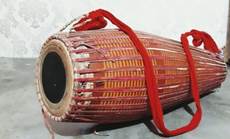
|
Figure 4 Khol |
Figure
5
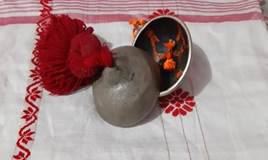
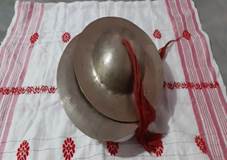
|
Figure 5 (A) Khuti tal (B) Pati tal |
Figure
6
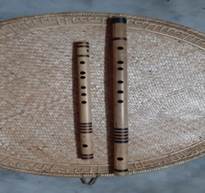
|
Figure 6 Banshi |
Figure
7
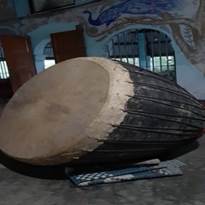
|
Figure 7 Doba |
Figure
8
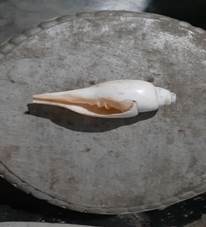
|
Figure 8 Sankha |
The appearance of the dancer also makes an
aesthetic statement. She should look slim and graceful, having an appealing
effect among the audience. The dancer should feel comfortable, look gracious
and dignified. She should not be overdress but select such costumes that
enhance her physical beauty. She should put on clothes that suits the rasas
depicted in the dance sequence. The colour should be in accordance with the
emotions and should be pleasant to the eyes. The aharya
should be such that it suits not only the dancer but also the choreographic
item. The attire not only make the dancer elegant but also aesthetically
attractive that they can immediately delight and captivate the eyes of the
spectators. In Sattriya dance, two attires are
observed: the male and the female costume. Ekharya
concept is also observed in choreographic works where abhinaya is profusely
depicted. The make-up too plays a distinctive role in adding glamour to the
dancer. The makeup differs according to various characters in ankiya naat. It is
necessary to keep in mind that besides the two broad divisions of attire mostly
seen performance on stage, each dance numbers in the repertoire have different
costumes, such as, jumura nac, nadubhangi nac, gopi nac, gohain pravesh nac, chali nac etc.
Figure 9
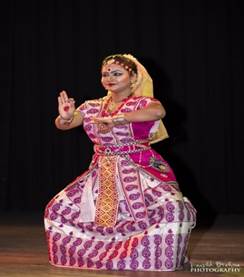
|
Figure 9 Female Attire Artist The author |
Figure 10
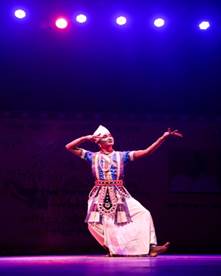
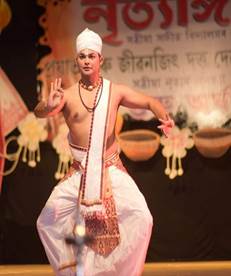
|
Figure 10 (A) Male Attire (B) Male Attire Artist
Niranjan Saikia
Artist Borish Dutta |
Figure 11
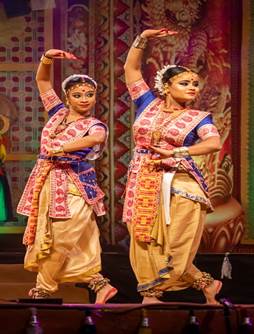
|
Figure 11 Ekaharya Artist Mousumi Borah and Juhimon Das |
The
use of lighting is another aesthetic feature that meets the need of the dance
composition. It enhance the entire atmosphere and
ignite the feelings among the audience to relish the rasa. Use of proper and
correct light according to the thematic purpose adds beauty to the composition
and create captivating and immersive experience for the audience. As Sattriya dance belongs to the theatre performances called ankiya bhaona, we
can observe while staging the ankiya bhaona, the conventional lightening methods were used
that enhance the aesthetic spiritual and religious aura of the entire
performance arena before the emergence of electric lights. Neog
said, “Light is provided on the stage with the help of large chandeliers (gacha), each holding about a hundred earthen cups
with mustard oil, torches (ariya) of burning
cloth soaked in such oil, large mustard oil lamps, and brilliant pyrotechnic
lights (mahata, mata or
mahala), lighted at the time of entrance of the chief actors or at the time of
dancing. Gas lights, petromax lamps and electric lights in the last instance
have been displacing these old and indigenous lighting arrangements” Neog (1984), P. 9-12. The
performers in ankiya bhaona
pass through an archway of lights consisting of nine earthen lamps representing
the nine forms of bhakti, called Agnigarh.
3. CONCLUSION
Aesthetic
is the art of moving the body rhythmically and links all perplexed meanings in
one perfect expression piece. Dance is an art and representation of artist’s
inner depth. It is believed, rasa is experienced by those who are emotionally
reactive or it is rightly said, beauty is only seen by those audience who can
grasp its beauty. Hence, the audience should be sahridaya,
able to feel or enjoy rasa and it is apparent only when the audience have a
knowledge on the pedagogy and understanding of the abhinaya performed in dance.
The nuances of Sattriya dance form and the distinct
system of rhythm not akin to other forms have given this tradition a separate
entity. These all-aesthetic attributes of Sattriya
dance form helps the audience to transcend the mind and heart in the ladder of
spiritualism.
The
audience experience different aesthetic pleasure while watching the Sattriya dance form but they finally merge in the bhakti
rasa, which is the significant rasa of the form. The presence of bhakti rasa in
Sattriya dance is beautifully witnessed by spectators
through its compositions which describes the stories of lord Krishna. The
bhakti rasa or bhava is the sthayi bhava in Sattriya dance and a spectator can relish the bhakti rasa
present in the dance form only if he has the minimal knowledge on the pedagogy
of the form. In one of the borgeets of Madhavadeva, he described:
“Ji Rasa Milise Brindavane /
Ae Sukha Nahike Tribhubane //” Kandali (2014), P.61
The
rasa that one experience in Brindavan is the ultimate happiness that cannot be
found anywhere else.
Similarly, all the rasas that one experiences while witnessing the dance form finally merge in the bhakti rasa, which prevails throughout the performance.
CONFLICT OF INTERESTS
None.
ACKNOWLEDGMENTS
None.
REFERENCES
Bandopadhay, S. (2010). Manipuri Dance: An Assessment on History and Presentation. New Delhi: Subhi Publications.
Beohar, C. J. (2015). Shastric Tradition in Indian Classical Dance. Delhi: Agam Kala Prakashan.
Chaudhay, A. (1991). Comparative Aesthetics: East and West. Delhi: Easyern Book Linkers.
Goswami, K. D. (2022). Ankamala. Guwahati: Banalata.
Goswami, U. N. (2019). Sattra Sanskritir Rup Baichitra. Guwahati: Purbayon Prakashan.
Kandali, M. (2014). Sattriya. Guwahati: Assam Prakashan Parishad.
Medhi, K. (1997). Ankawali. Guwahati: Lawerys Book Stall.
Neog, M. (1984). Bhaona the Ritual Play of Assam. New Delhi: Sangeet Natak Akademi.
Ramachandrasekhar, P. (2016). Dance Gestures (Mirror of Expressions). Mumbai: Giri Trading Agency Private Limited.
Roychoudhury, A. (2013, March). An Aspect of Relevance of Srimanta Sankardeva. The Blessed Island, 111. Assam: D.N Tamuly.
Saikia, G. (1997). Sattriyar Nrityar Ruprekha. Guwahtati: Rina Saikia.
Sankardeva, S. S., & Madhabdeva, S. S. (2016). Kirtanghosa Aru Naamghosa. Assam: Jyoti Prakashan.
Unni, N. (2014). Natyashastra (Vol. 2). Delhi: NBBC Publishers & Distributors (P) LTD.
|
|
 This work is licensed under a: Creative Commons Attribution 4.0 International License
This work is licensed under a: Creative Commons Attribution 4.0 International License
© ShodhKosh 2024. All Rights Reserved.

